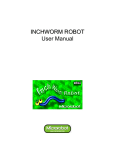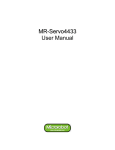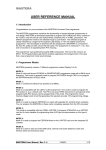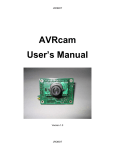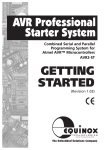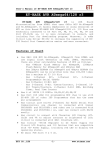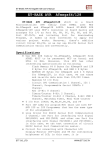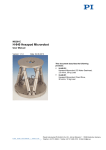Download MR-Servo8 User Manual(Eng).
Transcript
MR-Servo8 User Manual CONTENTS PART 1 : MR-Servo8 1. Introduction 2. Features 3. Control PART 2 : CPU Board 1. Placement Diagram (Silkscreen) 2. Circuit Diagram 3. Parts List PART 3 : Software Tools 1. AVR Development Program Installation 2. How to use WinAVR GCC 3. How to use PonyProg2000 PART 4 : Compile and Download 1. Compile and Download PART 5 : Source Codes PART 1 : MR-Servo8 1. Introduction MR-Servo8 is a small pre-assembled R/C(Radio Control) servomotor controller, which has 16 R/C servo connectable I/O pins. The MR-Servo8 can control up to 8 R/C servos at the same time. The MR-Servo8 uses an ATmega8(Atmel AVR series) CPU chip as a controller. The ATmega8 has a 4K bytes In-System Programmable Flash memory, 128 bytes SRAM, 256 bytes EEPROM and many other peripherals. The user can download a program to the board without a ROM Writer using the ISP function. A free C-compiler (WinAVR) is available. 2. Features • ATmega8 (Atmel AVR series, 16MHz X-tal(16 MIPS) but internal 8MHz RC Oscillator setting is required for the RC Servo Source Example. Refer to “Security Bit Settings for ATMega Family.pdf” for the setting. ) • 8K bytes ISP flash, 1K bytes SRAM, 512 bytes EEPROM, three Timers, ADC 8ch, UART • 16 R/C servos connectable (16 I/O port pins) • Controls up to 8 R/C servomotors at the same time • C source code • Free Windows C compiler(WinAVR AVR GCC) • ISP downloader(Optional) • On board piezo Buzzer 3. Control The board has sixteen I/O port pins and can control 8 servomotors at the same time. The ATmega8 CPU has three internal counters. The board generates up to eight periodic pulses using the timers. The periodic pulses control R/C servomotors. PART 2 : BOARD 1. Placement Diagram(Silkscreen) Fig 1.1 ATmega8 Servomotor control board silkscreen. 5 4 3 2 1 2. Circuit Diagram VCC VCC U1 D VCC VCC PD0(RXD) PD1(TXD) PD2(INT0) PD3(INT1) PD4(TO) PD5(T1) PD6(AIN0) PD7(AIN1) 4 5 R4 10K 18 20 21 /RESET C S3 + Tack 30 31 32 1 2 9 10 11 29 3 6 C3 1uF PC5(ADC5/SCL) PD0(RXD) PC4(ADC4/SDA) PD1(TXD) PC3(ADC3) PD2(INT0) PC2(ADC2) PD3(INT1) PC1(ADC1) PD4(TO/XCK) PC0(ADC0) PD5(T1) PD6(AIN0) PD7(AIN1) PB6(XTAL1/TOST1) 28 27 26 25 24 23 VCC GND 8 PB7(XTAL2/TOST2) 17 16 15 14 13 12 GND VCC 19 22 R1 470 C1 20pF 7 PB5(SCK) AVCC PB4(MISO) AREF PB3(MOSI/OC2) GND PB2(SS/OC1B) PB1(OC1) PC6(RESET) PB0(ICP) ADC6 ADC7 D PC5(ADC5) PC4(ADC4) PC3(ADC3) PC2(ADC2) PC1(ADC1) PC0(ADC0) Y1 16MHz PB5(SCK) PB4(MISO) PB3(MOSI) PB2(/SS) PB1(OC1) PB0(ICP) BZ1 BTG-47 D2 LED C2 20pF PB5(SCK) PD0(RXD) PD1(TXD) PD2(INT0) PD3(INT1) PD4(TO) PD5(T1) PD6(AIN0) PD7(AIN1) PC0(ADC0) PC1(ADC1) PC2(ADC2) PC3(ADC3) PC4(ADC4) PC5(ADC5) PB2(/SS) PB1(OC1) C J2 SERVO HEADER 48 ATMega8/TQFP 3 X 8 Header 100mil VCC 2 1 B VCC S1 C5 SLIDE 5267-2P J1 2 1 C4 + 5045-2P J5 104 VCC R5 10K R2 470 1 J4 VCC D3 PB0(ICP) D1 LED C6 104 VCC LED + R3 S2 Tack 2 VCC 470 100uF/10V PB3(MOSI) 10 8 /RESET 6 PB5(SCK) 4 PB4(MISO) 2 J3 + + + + + + + + + + B 9 7 5 3 1 CON10AP 2 1 5267-2P www.microrobot.com A Title Size A 5 4 3 Date: Document Number <Doc> 2 A MR-Servo4433 Sheet Rev 1.0 1 1 of 1 3. Parts List NO 1 2 3 4 5 6 7 8 9 10 11 12 13 14 15 16 17 18 19 20 21 22 23 Reference C1, C2 C3 C4 C5, C6 D1, D2, D3 J1 J2 J3 J4, J5 R1, R2, R3 R4, R5 SP1 S1 S2, S3 U1 Y1 Parts name Capacitor ” ” ” LED Connector ” ” ” Resistor ” BUZZER S/W ” MCU X-TAL Printed Circuit Board(PCB) Battery Holder & Power Connector Pin head Screw Nut Flat head Screw Downloading Adapter Ribbon Cable Value 30pF 1uF 100uF/10V 104(0.1uF) RED 3ø 5045 HEADER PIN(Male) CON10AP 5267 470Ω 10K BTG-47 SLIDE S/W Tack S/W ATmega8/TQFP 16MHz 5051-2P Qty. 2 1 1 2 3 1 1 1 2 3 2 1 1 2 1 1 Remark Ceramic Condenser Electrolytic Condenser Electrolytic Condenser Monolithic Condenser 5V Power Part SERVO HEADER 48PIN HIF3F/10PIN Battery Power Part PIEZO AVR Microcontroller ATS type 1 Main PCB 1 AA size * 4 4 12 4 3ø 3ø 3ø 1 Option 1 Option (1m) Fig 2.1 Downloading Adapter Fig 2.3 Battery Holder & Power Connector Fig 2.2 Ribbon cable PART 3 : Software Tools 1. AVR Development Program Installation AVR Development Tools There are many different kinds of development tools for AVR microcontrollers. Atmel, the AVR CPU manufacturer, provides some AVR development tools free. WinAVR GCC is a free Windows C-compiler. Wavrasm : AVR assembler, Atmel. AVR Studio : AVR Emulator/Simulator, Atmel. AVR ISP : ISP downloading program, Atmel. PonyProg2000 : ISP downloading program, Lancos. (Recommended) WinAVR GCC : C-compiler, GNU. (Recommended) System requirements for AVR development tools l Windows 9X/ME or NT/2000/XP l Pentium-133 or higher l At least 4 Mbytes of RAM l CD-ROM Drive AVR ISP installation: Run setup.exe in the CD’s avr_isp folder. WinAVR GCC installation Refer to “How to use WinAVR for Microrobot AVR Products(Eng).pdf”. 2. How to use WinAVR Gcc Refer to “How to use WinAVR for Microrobot AVR Products(Eng).pdf”. 3. How to use PongProg2000 Refer to the ‘PonyProg Manual for Microrobot AVR Products.pdf’and the ‘Security Bit Setting for ATMega Family.pdf’files. PART 4 : Compile and Download 1. Compile and Download Compile the source file and download the executable file in the following order. l Put four batteries into the battery holder and insert the power connector to J1 of the Main PCB. l Connect the downloading adapter to the PC printer port. Then connect the downloading adapter to the CPU board by using the ribbon cable. l Turn on the power switch S1 on the control board. LED D1 turns on. l Download sample code from our website (“How to use WinAVR for Microrobot AVR Products(Eng).pdf”). l Create a source folder and copy the prototype sample code, including the makefile, from the file you’ve downloaded. l Type “make all” on the DOS command line platform to compile it. l Debug and recompile if there are any errors or warnings. l If there are no errors, the ‘Errors: none’message appears. l Run PonyProg2000. l Do “I/O port setup” properly. Refer to ‘PonyProg Manual for Microrobot AVR Products.pdf’. l Select ‘Device → AVR micro → ATmega8’. l Select ‘File → Open Program File’and load the hex file. l Select ‘Command → Program’or press Ctrl + P to start downloading. If a ‘Program Failed’ message appears, select ‘Command → Erase’ or press Ctrl + E to erase the flash memory, and then try to program it again. l Remove the ribbon cable from the CPU board and restart the board. PART 5 : Source Codes Refer to “OWL ROBOT User Manual(Eng,mega8).pdf”. www.microrobot.com











